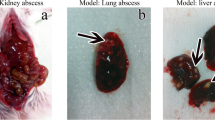Abstract
Kawasaki disease is the most common acute systemic vasculitis of unknown etiology in children [1] and can cause inflammation of the coronary arteries leading to aneurysms. Candida albicans extract is one of the materials commonly used to induce coronary arteritis in a mouse model of Kawasaki disease [2, 3]. Here we report an optimized method for preparing C. albicans cell wall extra (CAWE).
You have full access to this open access chapter, Download conference paper PDF
Similar content being viewed by others
Keywords
Kawasaki disease is the most common acute systemic vasculitis of unknown etiology in children [1] and can cause inflammation of the coronary arteries leading to aneurysms. Candida albicans extract is one of the materials commonly used to induce coronary arteritis in a mouse model of Kawasaki disease [2, 3]. Here we report an optimized method for preparing C. albicans cell wall extra (CAWE).
-
1.
80% of the mice administered CAWE that had been alkalinized at 87 °C showed massive inflammation around the origin of the coronary arteries. By contrast, the mice administered CAWE that had been alkalinized at 97 °C showed no inflammation.
-
2.
60% of the mice administered CAWE adjusted to 640 μg protein/mouse died within 2 days whereas 100% of the mice administered CAWE adjusted to 320 μg protein/mouse exhibited inflammation but survived.
In conclusion, high heat processing causes poor pathogenicity and high protein content causes excessive pathogenicity. Therefore, CAWE that has been heat processed at 87 °C and adjusted to 320 μg protein/mouse is optimal for the mouse model of Kawasaki disease.
References
Kawasaki T, Kosaki F, Okawa S, Shigematsu I, Yanagawa H. A new infantile acute febrile mucocutaneous lymph node syndrome (MLNS) prevailing in Japan. Pediatrics. 1974;54:271–6.
Murata H. Experimental candida-induced arteritis in mice. Relation to arteritis in the mucocutaneous lymph node syndrome. Microbiol Immunol. 1979;23:825–31.
Takahashi K, Oharaseki T, Wakayama M, Yokouchi Y, Naoe S, Murata H. Histopathological features of murine systemic vasculitis caused by Candida albicans extract—an animal model of Kawasaki disease. Inflamm Res. 2004;53:72–7.
Acknowledgment
We thank Kate Fox, DPhil, from Edanz Group (www.edanzediting.com/ac) for editing a draft of this manuscript.
Author information
Authors and Affiliations
Corresponding author
Editor information
Editors and Affiliations
Rights and permissions
Open Access This chapter is licensed under the terms of the Creative Commons Attribution 4.0 International License (http://creativecommons.org/licenses/by/4.0/), which permits use, sharing, adaptation, distribution and reproduction in any medium or format, as long as you give appropriate credit to the original author(s) and the source, provide a link to the Creative Commons license and indicate if changes were made.
The images or other third party material in this chapter are included in the chapter's Creative Commons license, unless indicated otherwise in a credit line to the material. If material is not included in the chapter's Creative Commons license and your intended use is not permitted by statutory regulation or exceeds the permitted use, you will need to obtain permission directly from the copyright holder.
Copyright information
© 2020 The Author(s)
About this paper
Cite this paper
Yoshikane, Y., Cho, T., Koga, M., Haraoka, S., Ogawa, A. (2020). Optimum Preparation of Candida albicans Cell Wall Extra (CAWE) for the Mouse Model of Kawasaki Disease. In: Nakanishi, T., Baldwin, H., Fineman, J., Yamagishi, H. (eds) Molecular Mechanism of Congenital Heart Disease and Pulmonary Hypertension. Springer, Singapore. https://doi.org/10.1007/978-981-15-1185-1_47
Download citation
DOI: https://doi.org/10.1007/978-981-15-1185-1_47
Published:
Publisher Name: Springer, Singapore
Print ISBN: 978-981-15-1184-4
Online ISBN: 978-981-15-1185-1
eBook Packages: MedicineMedicine (R0)




